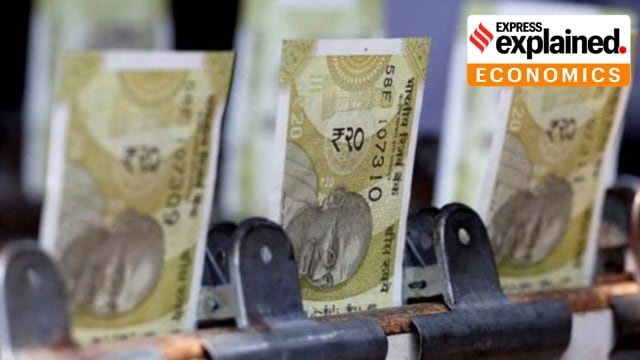Why rupee breached 86 against US dollar: strengthening dollar, weak FII inflows
The strong dollar, rise in crude oil prices and selling by foreign investors in the equity market are the major reasons for depreciation in the rupee.
 In the morning trades, the currency hit a fresh low of 86.31 against the greenback. (Photo: Reuters/File)
In the morning trades, the currency hit a fresh low of 86.31 against the greenback. (Photo: Reuters/File)The rupee fell past 86 on Monday on a strong dollar after better-than-expected US jobs data led to an expectation that the Federal Reserve will go for lesser interest rate cuts in this year.
Higher crude oil prices and continued outflows from foreign investors also weighed on the domestic currency. Forex dealers said the Reserve Bank of India (RBI) has been allowing the rupee to depreciate for the past few days.
How much has the rupee fallen?
The rupee opened at a record low of 86.12 against the US dollar on Monday. In the morning trades, the currency hit a fresh low of 86.31 against the greenback.
On Friday, the domestic currency closed at 85.97 after opening at 85.88 and touching an intraday low of 85.98 against the US dollar.
What has led to this fall in the rupee?
The strong dollar, rise in crude oil prices and selling by foreign investors in the equity market are the major reasons for depreciation in the rupee.
“This sustained decline (in the rupee) reflects a combination of global and domestic pressures. Global factors such as the US dollar continue its upward march, driven by the Federal Reserve’s cautious stance and solid economic data,” said Amit Pabari Managing Director CR Forex Advisors said.
On Friday, the US jobs report came out which was higher than market consensus. Headline Non-farm Payroll (NFP) print came in at 256,000 against expected 160,000. Even the unemployment rate came off to 4.1 per cent from 4.2 per cent.
“The market is now pricing in just one 25bps (basis points) cut by the US Fed in 2025,” said forex advisory firm IFA Global.
Robust economic data in the US has pushed US 10-year yields higher, triggering capital outflows from emerging markets like India. The ripple effect has been significant, with approximately $4.2 billion exiting Indian markets in January 2025 alone.
“Compounding the rupee’s woes is the sharp rise in crude oil prices, which has placed further strain on India’s current account. As a net importer of oil, India faces heightened fiscal stress whenever crude prices surge, weakening the rupee’s resilience,” said Pabari.
Meanwhile, the dollar index, which gauges the greenback’s strength against a basket of six currencies, was trading 0.27 per cent higher at 109.95. The 10-year US bond yields also rose to 4.71 per cent.
Brent crude, the global oil benchmark, surged to USD 81.23 per barrel in futures trade.
What is the outlook on the rupee?
The rupee is expected to trade within the 85.80–86.50 range in the near term, with heightened volatility likely as market participants digest upcoming policy announcements, including those linked to US President Donald Trump’s announcements after taking over charge as president on January 20, Pabari said.
- 019 hours ago
- 028 hours ago
- 039 hours ago
- 049 hours ago
- 059 hours ago






































